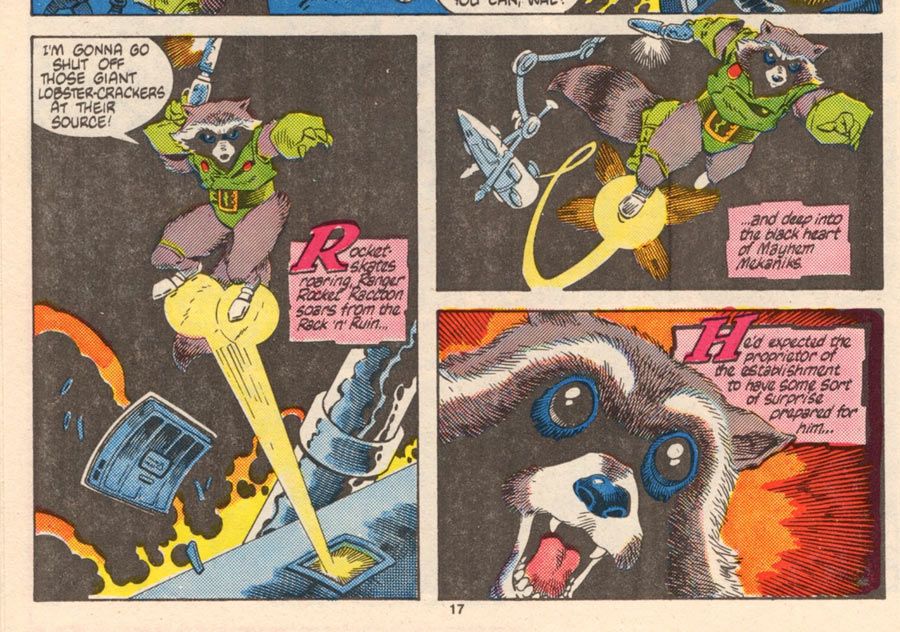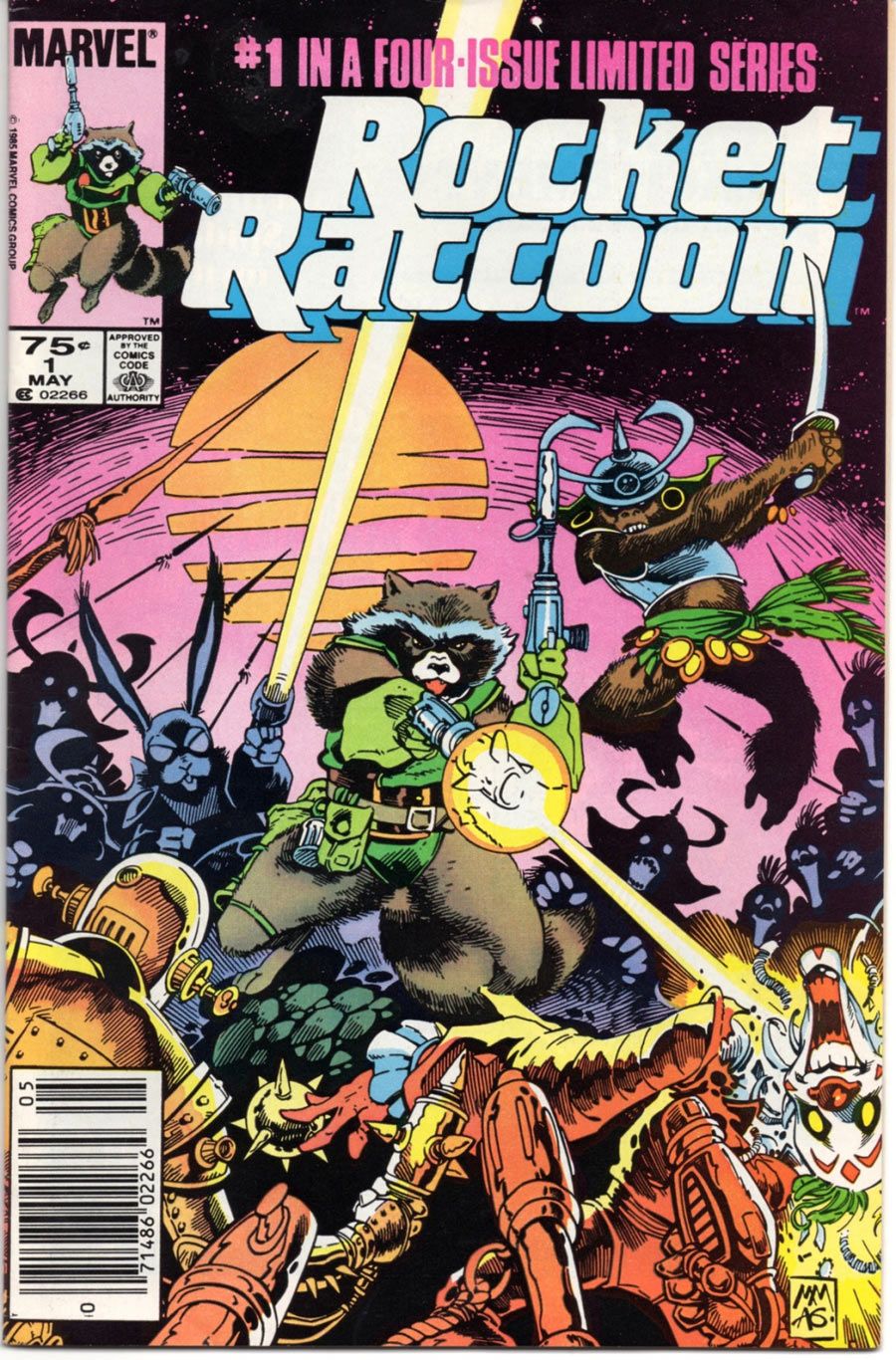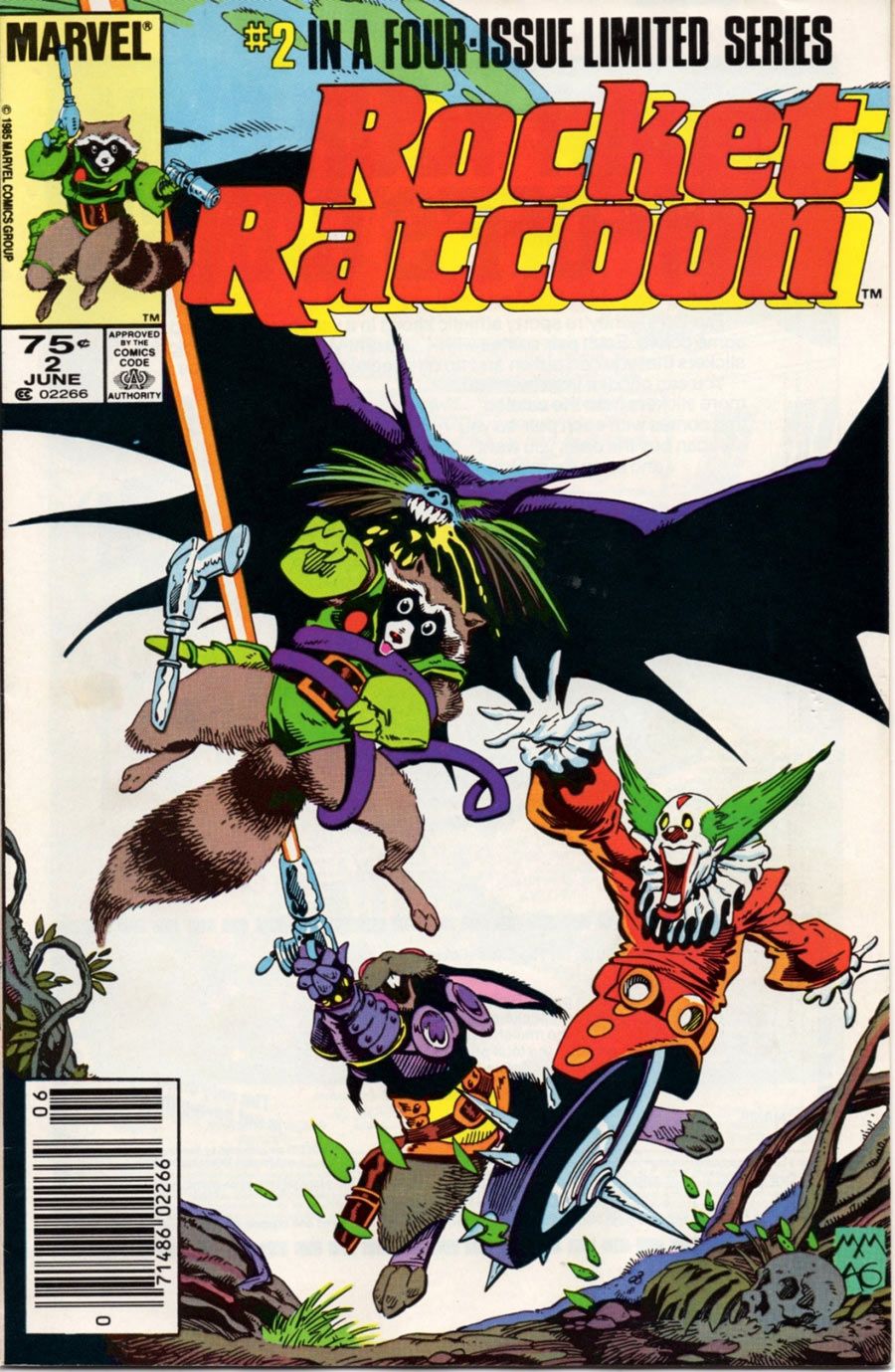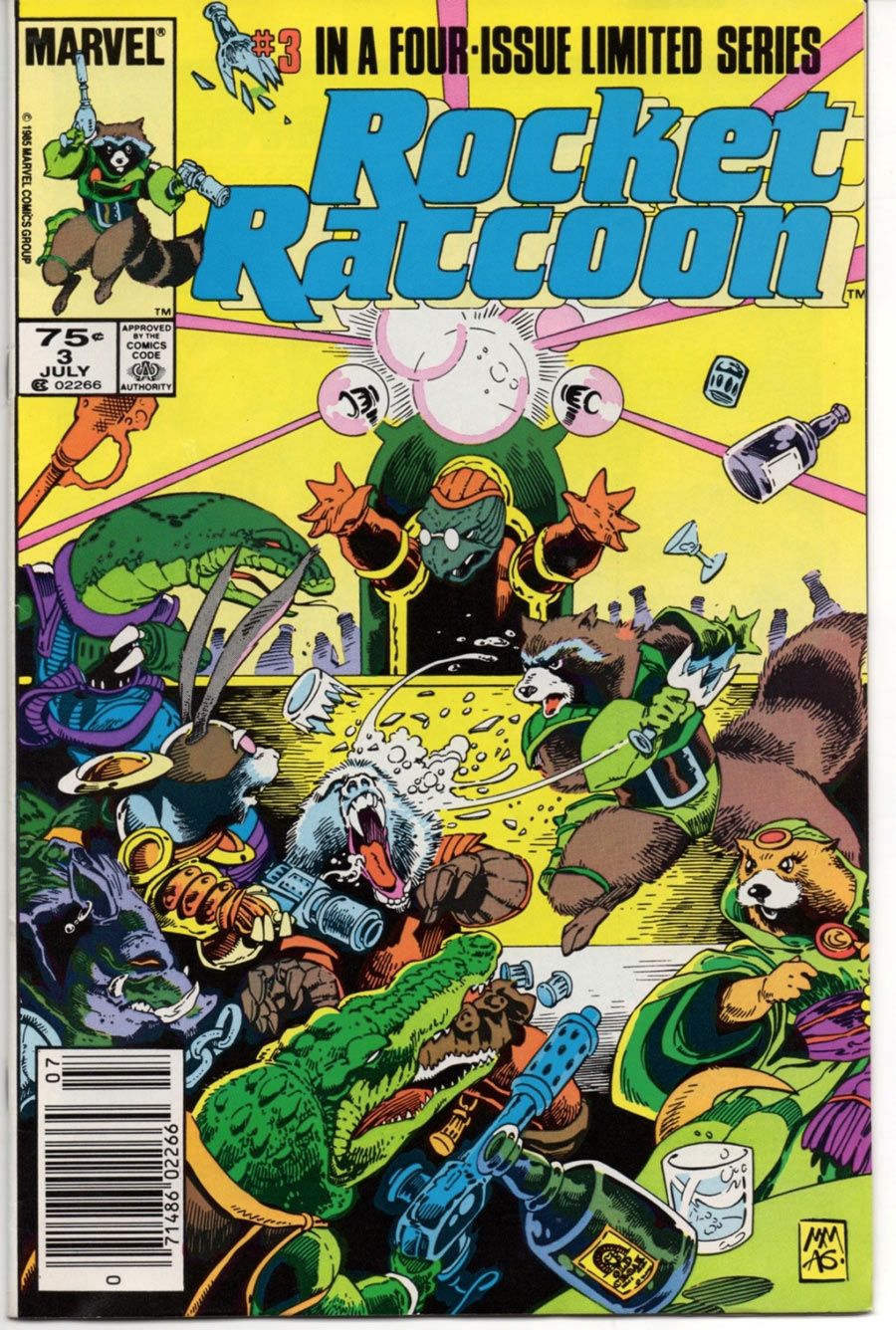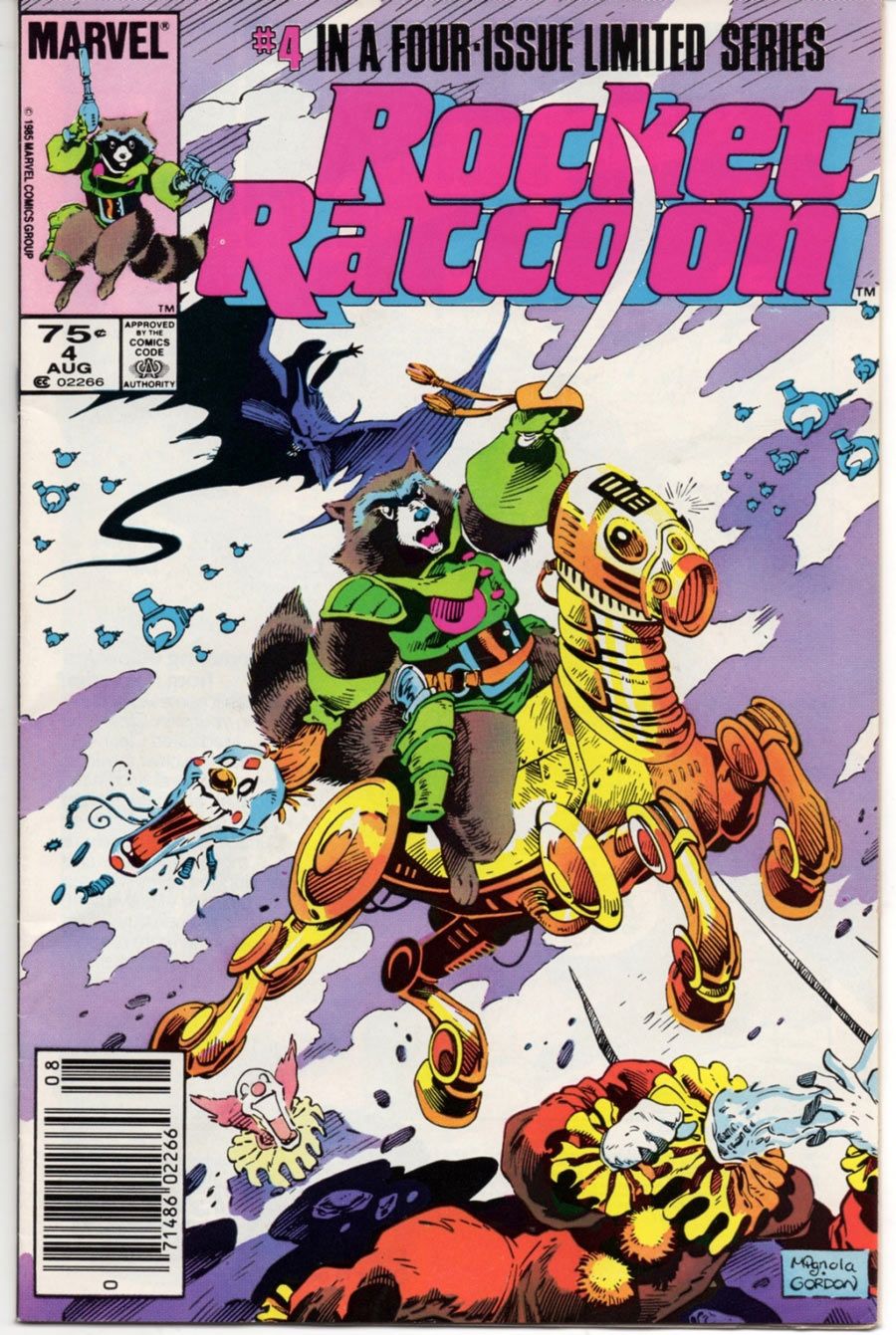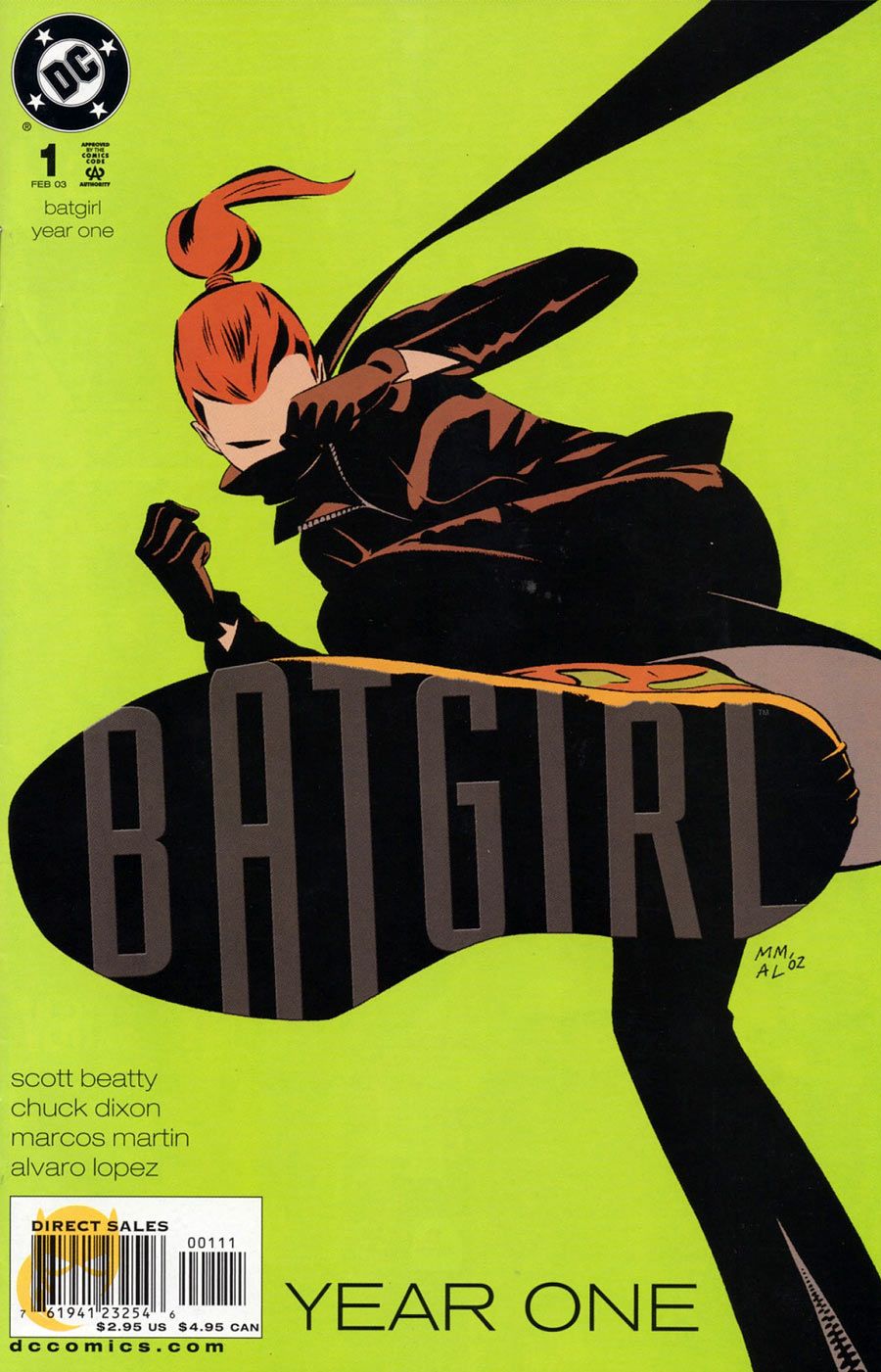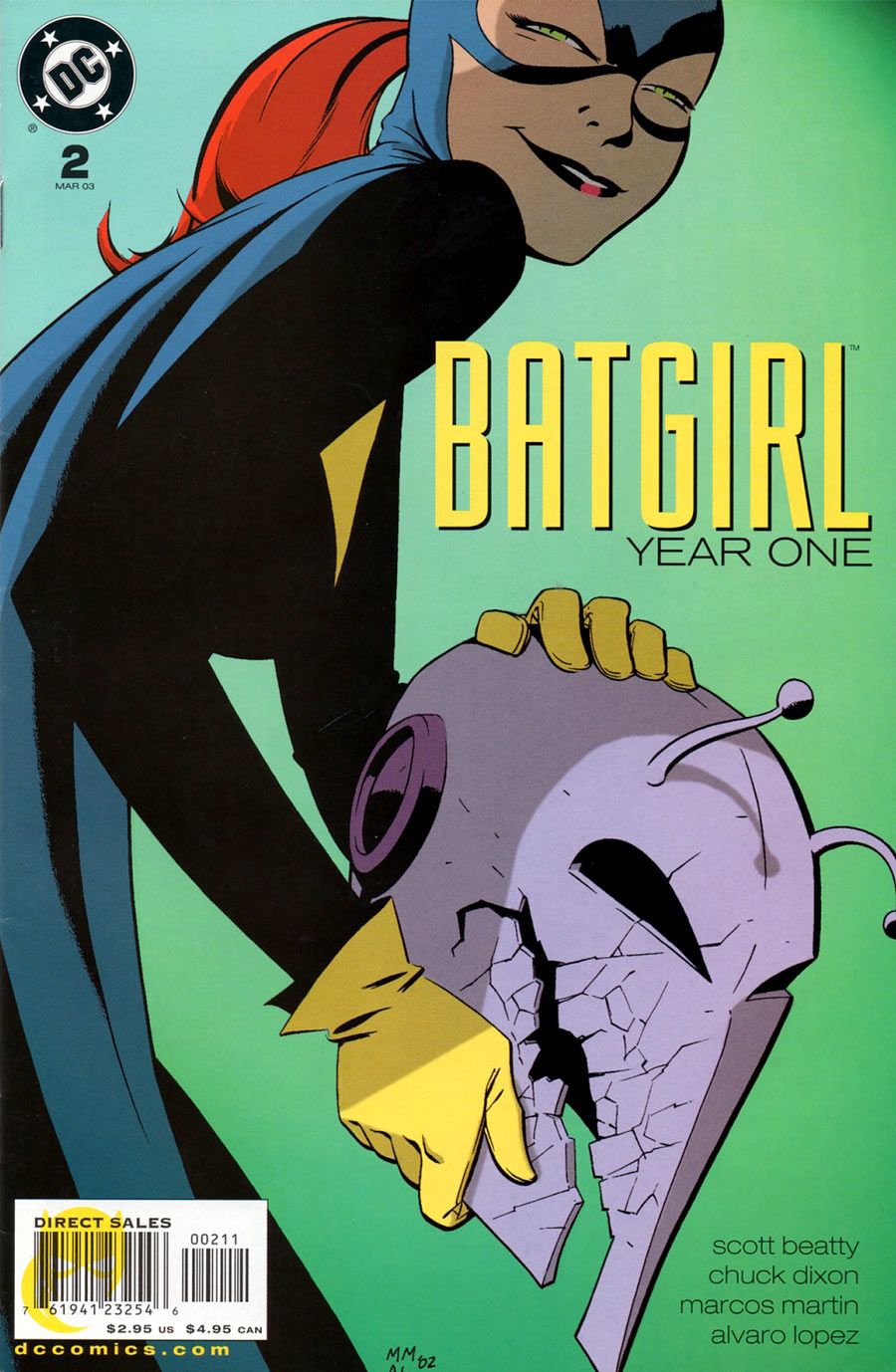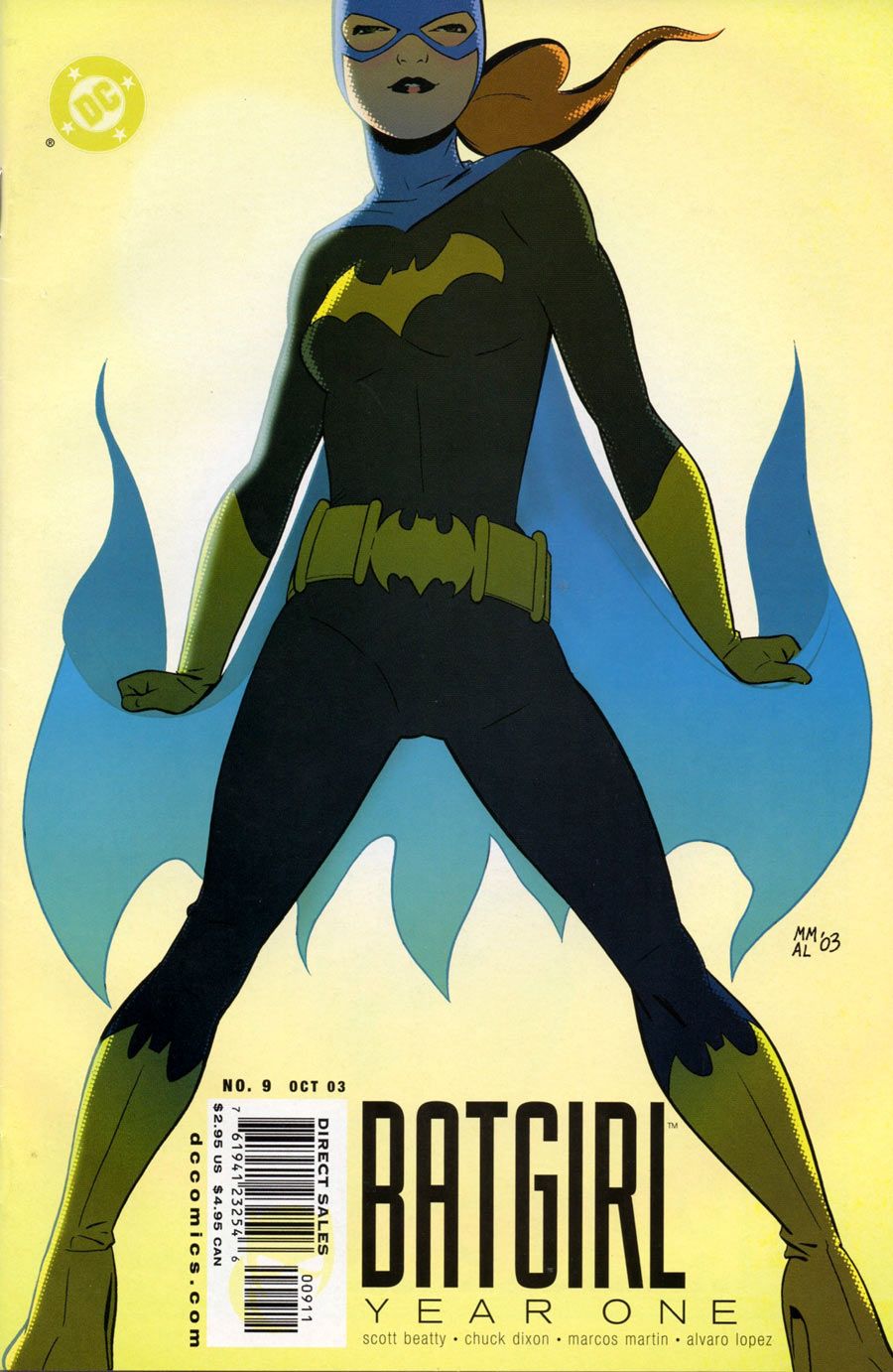THE ROCKET RACCOON COMIC YOU WERE LOOKING FOR
Back in 1985, Marvel Comics published a four-issue limited series featuring a talking animal hero whose name wasn't Howard the Duck.
This was the "Rocket Raccoon" miniseries, which deftly provided an origin story for the raccoon when you weren't noticing. Rocket and his friends -- most notably a walrus with interchangeable tusks and an otter girlfriend -- live on a planet named Halfworld, populated by insane humans in straightjackets, robots who serve them, and talking animals who entertain them. Rocket is both a scholar and an adventurer. While he's quick with his sword or laser blaster, what he's most interested in is uncovering the secret history of the planet and how they all got there -- and whether they'll ever be able to get off of it.
Does that sound half crazy to you yet? Good, then I can fill in the other half: The planet is on the brink of war as the two leading toy manufacturers are out for each others' blood. Also, Rocket's girlfriend is, in some convoluted way, the next of kin to the original owners of one of the toy factories. The soldiers the one manufacturer sends forth are some rhyming clowns, but don't overlook the evil bunny rabbit, Blackjack O'Hare (no relation to Bucky), or the turtle, Uncle Pyko.
It's a lot to take in. Thankfully, Bill Mantlo writes the book in the style of the times: densely. Each page is packed with panels, and each panel has lots of dialogue. Characters use each other's names constantly, which is a big help with such a large cast. It's tough going to read all four-issues in one sitting once you've become accustomed to the modern writing styles.
Perhaps tougher to get used to in this mini is the print quality. We're really spoiled now between not just the computer coloring, but also in the paper quality and reproduction preciseness. The art in this book suffers at times from being on newsprint with rough coloring. I wanted to see a modernized version of this issue, but then I remembered that the way those conversions happen, we're likely to lose even more lines that way.
Speaking of art, did I mention the artist yet? Mike Mignola. Yes, in humbler times, the creator of "Hellboy" drew a talking animals book set on an alien planet with killer clowns, shrews, turtles, and countless other species. Every now and then, Mignola's distinct style comes out strongly. The backgrounds and their solid black areas combined with the crosshatching and billowing clouds of smoke are obvious Mignola trademarks.
Al Gordon's inks are a big help. You can see Mignola's style in there, but the inks are crisp and clean on top of it. I think Gordon is one of the underrated inkers of the last 30 years as it is, but the work in this book would rank up there, as far as I'm concerned, with the likes of Terry Austin. It's a lot of lines and a lot of little ink tricks happening all at once, but Gordon keeps things clear and easy to parse. I'm sure if the reproduction standards were higher back then, it would be even more noticeable and impressive.
You can download a digital version of this miniseries, and Marvel did put out a hardcover collection in their now-discontinued "Marvel Premiere Edition" format. The inks do look good, but you're temporarily blinded by the colors. They're just too bright, too primary. The newspaper muddies up the coloring a bit and darkens it. I understand that, but the overall effect is just too much. The colors need to be a bit more subdued. Let the art tell the story.
The other issue is that flat digital colors often look too flat. Because they don't have the texture from the paper or the dotted patterns from the printing process, they look too simple. Those flat gray and purple characters in the background were done that way because it's all they could do back then. Today, we'd expect some shading in that area. Your eye sees gaps to fill.
Judging from the pages I've seen digitally, though, I'll give Marvel's production staff credit for fixing some obvious gaffes, such as where the colors went outside the lines, or where a minor shift in a color's shade could use a gentle push to make it stand out a bit more.
"Rocket Raccoon" is a bizarre yet enjoyable four-issue miniseries. It's of its time in some ways, but not as badly as some other work of the period would feel today. In whatever format you buy it, you'll get your money's worth. I found mine in a back issue bin years ago and finally got around to it this last week. It is available digitally for just a couple bucks an issue. The hardcover is long out of print, so good luck with that.
As a bonus, here's a scan from the text page at the end of the first issue. Marvel had Bill Sienkiewicz do caricatures of the creators of the series. From lower left to upper right, that's Mike Mignola, Bill Mantlo, Al Gordon and Carl Potts. They all shared one big brown head of hair in those days, it seems.
I'm half shocked I haven't seen this on Bendis' Tumblr already. Must have missed that post.
THE BATGIRL COMIC YOU'VE BEEN ASKING FOR
Ladies and gentlemen, brothers and sisters, I'm pleased to announce that DC has heard your comments. It's heard the swell of support for one of its leading characters. In response, it has published the most perfect "Batgirl" comic, filled with action, adventure, a feminist hero, a strong character who won't take no for an answer and who learns a lot about herself along the way.
You have to go back ten years, but DC did it in the form of "Batgirl: Year One."
In case you missed it the first time, the nine-issue miniseries follows Barbara Gordon from the moment she decided to go into crime fighting through to her acceptance by Batman. Along the way, there are plenty of small winks and nods to the continuity of the Bat books at the time, as I recall, but the series is still very enjoyable even without that knowledge. Those bits are just details that won't get in the way. If you like the high points of the Batman Universe, you'll like how a lot of little things are explained or poked fun at along the way. The book is a loving tribute to Batman, in some ways, but mostly to Barbara Gordon, the quiet librarian daughter of Commissioner Gordon who has a crazy dream of her own.
If anything, the book can poke you in the ribs a bit too hard a few times, leaning on omens and portents and quotes from the Oracle. Wink wink, nudge nudge. But for the most part, those moments are filled in nicely by the reader between caption boxes and the story proceeds apace.
Chuck Dixon and Scott Beatty are responsible for the story. At the time, Dixon was busy tearing up the Batman Family of titles -- handling "Birds of Prey," "Nightwing," and "Robin" all at the same time. And, best of all, they were excellent books with great artists that ran at breakneck speed. You knew they were Dixon's books, and the continuity between them worked, the relationships were strong, and the adventure was varied and fun. This is a man, remember, who found a way to keep a long conversation between Robin and Nightwing about their love lives from being boring by staging it atop a moving train. Blindfolded.
Scott Beatty was a frequent writing collaborator with Dixon at the time, working with him on "Joker: Last Laugh," the previous "Robin: Year One" miniseries, and solo on some "Secret Files" books. He'd later take over "Ruse" from Mark Waid at CrossGen, and eventually return to DC with Dixon for "Nightwing: Year One." (Martin did not return to that one, which is the least of the three "Year One" books.)
All of the classic Dixon writing tics are present in this book, as well. Batgirl attempts to get Black Canary's attention by breaking into the JSA Headquarters and leaving a note. She rides a motorcycle through the Gotham subways at Robin's speed. She holds her own against both superpowered costume folks and street toughs looking to hold up a convenience store. She does it without formal Bat-training, just a wealth of knowledge and the ability to think quickly to work her way out of a situation.
And for as smart as she is, she never realizes just how smart she is, making cracks about things that are logical -- and true, such as the time she guesses that Batman must be rich to afford all the equipment he has. Barbara Gordon was funneling money from her day job to support her Bat-gear habit. It was a drain on her meager earnings.
The book is more than the sum of its parts, showing Gordon as she grows quickly into her role, working with Black Canary and Robin (with Batman watching quietly from the shadows) mostly against Killer Moth and Firefly, two minor villains that Dixon and Beatty do a great job on making into credible threats. The fifth issue is basically devoted to Firefly's origin and getting him working with Killer Moth. Firefly is the greater threat, less predictable and slightly crazy. Killer Moth is a little more delusional, in a funny way that still packs some power. Batgirl's lack of experience makes him even more dangerous.
The story structure plays with time very well. Often, the issues happen at two different times, before the timelines merge and you see how Batgirl got to where she was going. It happens in different ways throughout the miniseries, so you need to pay attention and follow the caption boxes closely at times. It's not challenging or difficult, but you will get more out of it if you don't just try to breeze through.
But the star of the book, aside from Barbara Gordon, is the artist. This is early work from Marcos Martin, currently working with Brian K. Vaughan on "The Private Eye", and much beloved for his work more recently on "Daredevil" and "The Amazing Spider-Man." "Batgirl: Year One" was his first work longer than a fill-in at DC, and it shows plenty of hints of the genius we've since come to expect. He's not being too crazy with the page design or layouts yet, but he already has a firm grasp on his own style. It's the angles that work so well. It's a good variety of medium shots mixed with worm's eye views and high overhead shots, where appropriate.
With inks from Alvaro Lopez, Martin's art keeps an open style, with line work that mixes in some solid black areas, but usually stays thin with a small variety of line weights to keep things looking lively. Lopez can also do more dramatic line feathering and spots where motion is needed, but that's few and far between. The overall look is streamlined and clean.
No small part of Martin's style is the coloring that comes with it. This is much like the way "Batman Adventures" would work (with Mike Parobeck or Tim Levins), where the well-defined shadows are a key part of the overall look. They elevate the art into something that has that cel shaded look. Credit goes to Javier Rodriguez for the colors on the series, who matches Martin's style, keeping the colors solid and well-defined, but adding depth where it belongs. The palette doesn't try to be realistic. It works as a comic book style, with brighter colors for costumed characters, and scenes that are color keyed on tans, or dominated by blue, gray, or yellow backgrounds. We're not looking at mud with this book, which another colorist might easily slip into as an attempt to portray the dirty back alleys of Gotham. With the exception of a few Photoshop effects for flames and fancier sky effects, the overall look is timeless and perfectly complements the art.
I'm reminded of the gag credit at the end of "Tiny Toon Adventures" one time that read "Secret of Good Quality Animation: Lotsa Shadows." That affect works here, as well.
"Batgirl: Year One" is not just a great Batgirl comic and a great Batman Family comic, but also a good comic overall. Everyone worked well together here. There's no weak link. If you're a modern Batgirl or Oracle fan, you'll find something to like in this book, as well, even if it technically "doesn't matter" in the New 52.
The trade paperback of the nine issue miniseries should still be available today, packaged together with the "Robin: Year One" miniseries, as "Batgirl/Robin: Year One". It's over 400 pages of great comics for $24.99. If you can still find a copy, jump on it.
PIPELINKS
- Not a link, just a quick pitch to Scott Dunbier: "Artist's Edition: Don Rosa's 'Uncle Scrooge'" would make an excellent Christmas gift for all Duck fans next year. Release it close to Christmas, at the one time of year that Disney actually admits that they have a character named "Scrooge" in their IP vault and let him loose at a theme park or two.
- The Rob Liefeld interview over on the Inkstuds podcast is a great listen. Liefeld isn't afraid to say what he thinks, which makes for an entertaining hour, including all of the impressions you want out of the man. He's a quote machine, energetic and ready to share memories from the early days of Image and his time at Marvel and DC that'll bring up fun memories. For example, Liefeld says of Todd McFarlane's Mary Jane Watson-Parker, "His MJ is, like, how low can it go? She looked like she jumped out of the 'Cherry Pie' video." By comparison to what came before and particularly later in his run, he's right, though Erik Larsen would take it even a step further with the poutiest lips you've seen on a woman since Melanie Griffith.
- I just love Todd Nauck's drawing here of Betty and Veronica.
- Want to watch Skottie Young draw, but don't have a lot of time? He posted a sped up video from a recent sketch to enjoy. It's amazing to watch how he lays the inks in, particularly on the father's clothes and on the moon.
- The McSpidey Chronicles will return next week, along with another book from the past I recently reread...
Twitter || E-mail || Instagram || Pipeline Message Board || VariousandSundry.com || AugieShoots.com || Original Art Collection || Google+

